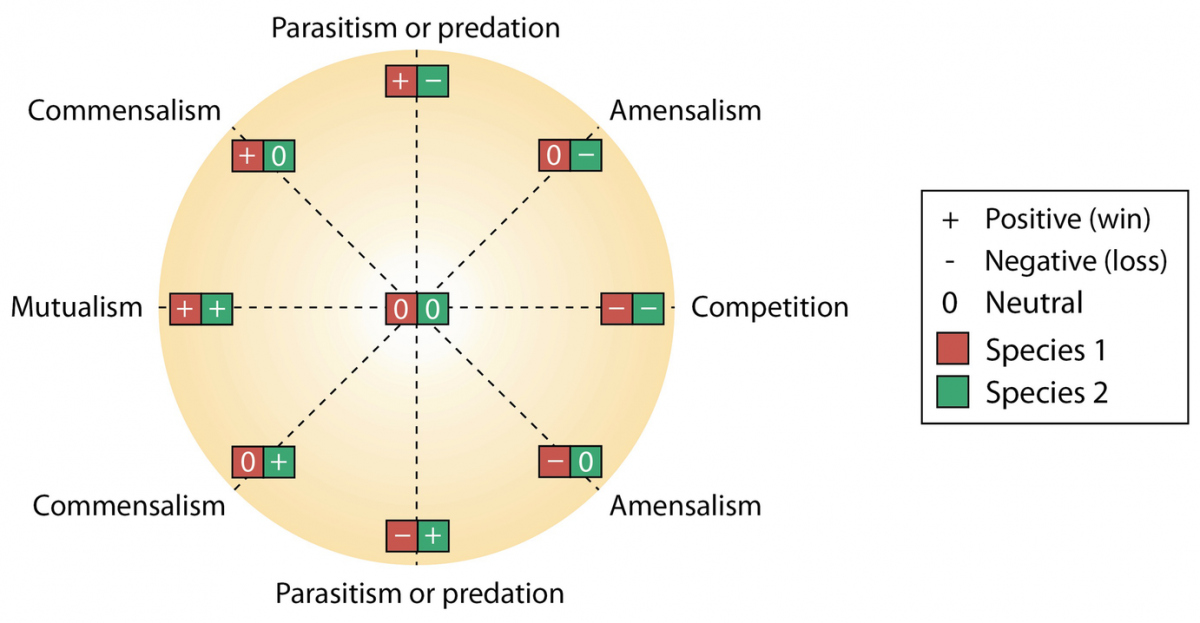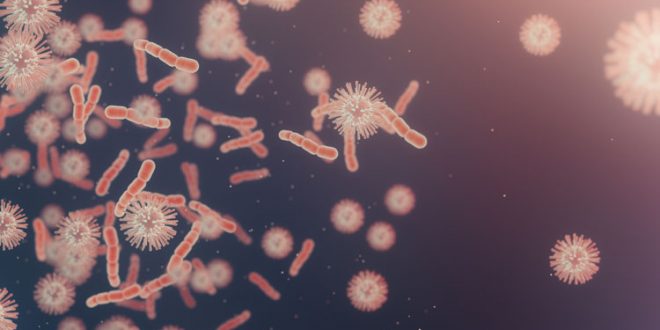Organisms living together in a community influence each other directly or indirectly under natural conditions. All vital process of living such as growth, nutrition, reproduction required interactions between individuals of same species, or between species which are inter and intra-related. Such relationships of individuals in a population of an ecosystem is called biological interaction.
Generally, interaction between microbial communities is known as interaction between microbial population. Interactions are two types.
- Positive
- Negative

Positive interaction
In this type of interaction, populations help each other. Positive interactions may be one way or reciprocal. The benefits may be in respect of food, shelter etc. It may be continuous, transitory, obligate or facultative. In population, it is generally known as ‘cooperation’.
Different types of positive interactions are:
- Mutualism
- Commensalism
- Synergism
1. Mutualism
Best safe and secure cloud storage with password protection
Get Envato Elements, Prime Video, Hotstar and Netflix For Free
Best Money Earning Website 100$ Day
#1 Top ranking article submission website
Mutualism relationships between populations can be considered as extended synergism. It is an obligatory relationship between two populations that benefits both populations.
- A mutualistic relationship is highly specific and restricted.
- One member of association ordinarily can’t be replaced by another related species.
- It is also known as Symbiosis.
For example:
The relationship between bacteria called nitrogen fixing bacteria and certain plants has been called nitrogen fixing symbiosis, rather than mutualism.

Lichen is the relationship between Cyanobacteria or algae and fungi, is one type of mutualism. Lichen is composed of primary producer (phycobiont = algae) and a consumer (mycobiont = fungi). Phycobiont converts radiant energy to organic compounds. Mycobiont takes this organic compounds from algae or phycobiont and gives protection to the algae or phycobiont.
Protozoas persisted with algae is another type of endosymbiotic relationship or mutualistic relationship. Paramecium, a protozoa can host numerous cells of Chlorella algae within it’s cytoplasm. Details here.
One of the most interesting mutualistic relationships between a protozoan & a bacterium is between Paramecium and Caedibacter endosymbiont, known an kappa particles. Paramecium strains possessing the particles are known as “killer paramecia”. They liberate a substance also known as paramecin into the culture medium that is lethal to Paramecium that do not contain kappa particles. On the other hand, Caedibacter contains cytoplasmic protein inclusions called R bodies which act as a toxin delivery system.
2. Commensalism
In this type of relationship, one population benefits while the the other remains unaffected.

The word ‘commensalism’ is derived from Latin word “Mensa”. Although commensalism is common between microbial populations but it is not obligatory. Commensalism is unidirectional relationship between two populations where the unaffected population doesn’t get benefit and isn’t negatively affected.
For example, when a population is facultative anaerobic, use oxygen for their metabolic activities, but in lack of oxygen environment, they create a habitat which is suitable for the growth of obligatory anaerobes.
Desulfo vibrio excretes acetate and hydrogen by breakdown of organic matters from anaerobic respiration which is taken by Methanobacterium to produce methane from CO2. It is a commensal relationship.
3. Synergism (Proto co-operation)
A relationship of synergism between two microbial populations indicates that both populations benefit from the relationship. But the association is not obligatory because both populations are capable of surviving in their natural habitat on their own.

Example: A classic example of synergism is exhibited by Enterococcus faecalis and E. coli. Neither organism is able to convert arginine to putrescine. E. faecalis is able to convert arginine to ornithine. Then only, E. coli used this ornithine to produce putrescine. Otherwise, E. coli converts arginine to agmatine. But putrescine can not be produced alone by any of two organisms. This relationship is known as Synergism.
Negative Interactions
In negative interactions, one of the interacting populations is benefited and the other is harmed. In negative interaction, one population may eat the members of the other population to compete for foods & excrete harmful wastes. Different types of negative interactions are:
- Competition
- Amensalism (Antagonism)
- Parasitism
- Predation.
1. Competition
Competition represents a negative relationship between two populations in which (both) populations are affected by others for their survival & growth. Competition occurs when two populations use the same resource and space in a limiting environment. It may occur for any growth limiting resources.
- Competitive exclusion principle is applicable. (More will be added later).
- It plays a key role in natural selection.
A classic example of competition is two closely related populations of Protozoa, Paramecium caudatum and P. aurelia.
2. Antagonism or Amensalism
Amensalism is completely opposite to synergism. Microorganisms that produce toxic substances to competing populations will be known as amensalism. So, when microbial population produces a substance that is inhibitory to other population, this inter population relationship is known called amensalism. The first population may be unaffected by the inhibitory substances or may gain a competitive edge that is beneficial.
The term antibiosis and allolopathy have been used to describe such cases of chemical inhibition, for examples virucidal factor in sea water and fungistatic factor in soil. Once an organism establishes itself within a habitat, it may prevent other populations from surviving in that habitat. E.g. Penicillium & Staphylococcus aureus.
The production of lactic acid on fatty acids are inhibitory substances for bacterial population.
3. Parasitism
In this relationship the population that benefits is the parasite. It derives its nutritional requirements from the host which is harmed. Normally host – parasite relationship is quite specific.
Example: E. coli (host) and viral phages (parasite).
4. Predation
- The association stands for a short time.
- One organism eats and kills another.
- Predators are highly specialized for hunting.
Revised by
- Md. Siddiq Hasan on 16 march, 2020
Best safe and secure cloud storage with password protection
Get Envato Elements, Prime Video, Hotstar and Netflix For Free
 Plantlet The Blogging Platform of Department of Botany, University of Dhaka
Plantlet The Blogging Platform of Department of Botany, University of Dhaka





